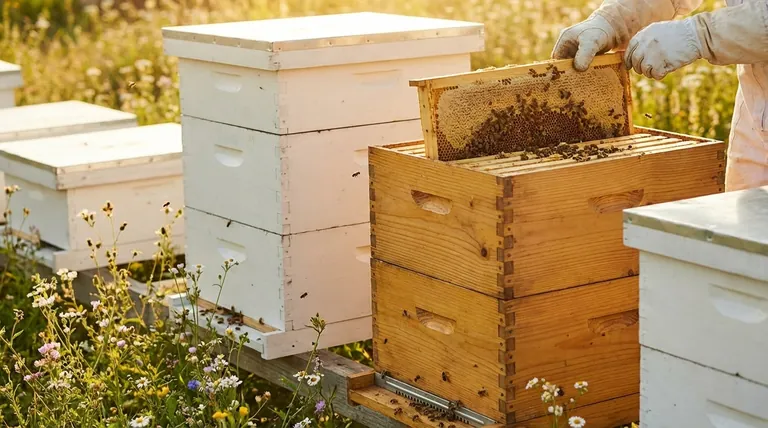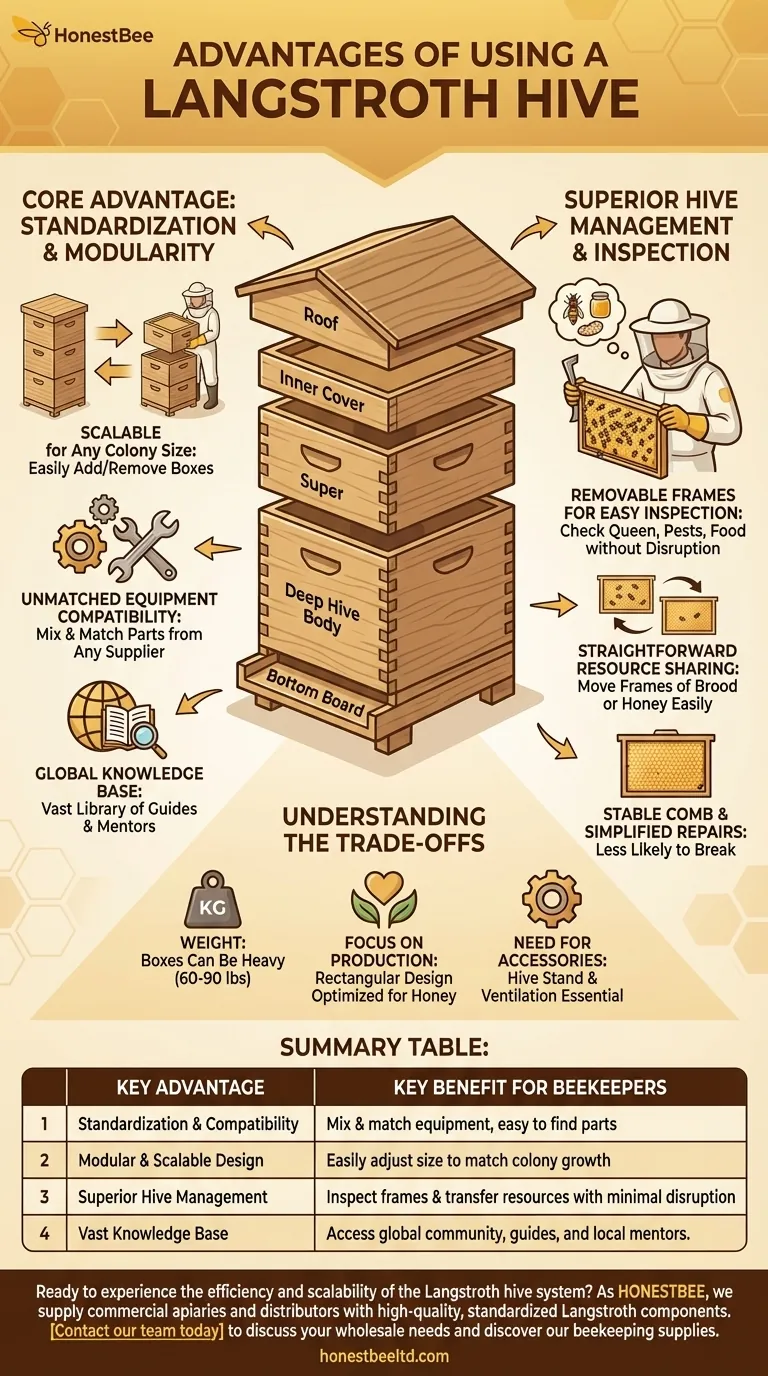The fundamental advantage of a Langstroth hive is its combination of modularity and standardization. This design allows beekeepers to easily expand or shrink the hive, manage the colony with minimal disruption, and source compatible equipment from virtually any supplier.
While many hive types exist, the Langstroth system's global adoption has created an unparalleled ecosystem of shared knowledge and interchangeable parts, making it the default choice for both commercial and beginner beekeepers focused on productivity and management efficiency.

The Core Advantage: Standardization and Modularity
The Langstroth design revolutionized beekeeping by introducing a system of standardized, interchangeable components. This principle is the source of its most significant advantages.
Unmatched Equipment Compatibility
Because the Langstroth hive is the most popular style in many countries, its dimensions are standardized. This means you can mix and match equipment—like boxes, frames, covers, and feeders—from different manufacturers.
This compatibility ensures you can always find replacement parts and that your initial investment will remain relevant as your apiary grows.
Scalable for Any Colony Size
The hive is fundamentally a set of stackable boxes, often called supers. You can easily add more boxes to give a growing colony more space for brood or honey storage.
Conversely, you can remove boxes to consolidate a smaller colony for winter, making the hive adaptable to the natural ebb and flow of the bee population throughout the year.
A Global Knowledge Base
The hive's immense popularity means there is a vast and readily available library of books, online guides, and video tutorials covering every aspect of its management.
Finding a local mentor or beekeeping club that uses Langstroth equipment is also far easier, significantly shortening the learning curve for beginners.
Superior Hive Management and Inspection
The Langstroth's design isn't just about standardization; it's engineered for efficient, hands-on beekeeping.
Removable Frames for Easy Inspection
The defining feature of the hive is its removable frames, which hang inside the boxes. These frames are separated by a precise gap known as "bee space."
This allows the beekeeper to pull out individual frames to inspect the queen's laying pattern, check for pests and diseases, and assess food stores without destroying the comb or overly disturbing the bees.
Stable Comb and Simplified Repairs
Frames provide stable attachment for the comb on three or four sides. This makes them far more durable and less likely to break during an inspection compared to the free-form comb found in other hive types.
If a piece of comb does break, it can often be easily repaired and secured back into a frame.
Straightforward Resource Sharing
The ability to move frames makes apiary management incredibly efficient. You can easily transfer frames of brood, pollen, or honey from a strong hive to a weaker one to help it grow. This is a common and powerful management technique that is simple to execute in a Langstroth hive.
Understanding the Trade-offs
No hive design is perfect for every goal. To make an informed decision, you must understand the Langstroth's limitations.
The Weight of Hive Boxes
A deep hive body or a shallow super full of honey can be extremely heavy, often weighing 60-90 lbs (27-41 kg) or more. This can present a significant physical challenge for some beekeepers. Using all medium-sized boxes is a common modification to mitigate this issue.
Focus on Production over "Naturalness"
The Langstroth's rectangular design and focus on uniform frames are optimized for honey production and ease of inspection. Beekeepers prioritizing a more "natural" or "bee-centric" approach may prefer other styles, like Top Bar or Warre hives, which allow for more natural comb development.
The Need for Accessories
While the basic hive is simple, effective management often requires optional parts. A hive stand is critical for keeping the hive off the damp ground and protecting it from pests. Likewise, an inner cover and proper ventilation are essential for managing moisture and condensation, especially during winter.
Making the Right Choice for Your Goal
Your choice of hive should be dictated by your primary objective as a beekeeper.
- If your primary focus is honey production and management efficiency: The Langstroth is the undisputed standard due to its scalability and the ease of inspecting and manipulating frames.
- If your primary focus is ease of learning and community support: The Langstroth is the ideal choice because of the unparalleled availability of educational resources and compatible equipment.
- If your primary focus is a "hands-off," natural beekeeping style: You can practice foundationless beekeeping in a Langstroth, but you may find a Top Bar or Warre hive is more philosophically aligned with your goal.
Ultimately, the Langstroth hive's design empowers the beekeeper with control and a wealth of proven management options.
Summary Table:
| Key Advantage | Key Benefit for Beekeepers |
|---|---|
| Standardization & Compatibility | Mix and match equipment from any supplier; easy to find parts. |
| Modular & Scalable Design | Easily add/remove boxes (supers) to match colony size and honey flow. |
| Superior Hive Management | Inspect frames, check for disease, and transfer resources with minimal bee disruption. |
| Vast Knowledge Base | Access a global community, extensive guides, and local mentors for support. |
Ready to experience the efficiency and scalability of the Langstroth hive system?
As HONESTBEE, we supply commercial apiaries and beekeeping equipment distributors with high-quality, standardized Langstroth hive components through our wholesale-focused operations. Our equipment is designed for durability and seamless integration, helping you maximize productivity and simplify colony management.
Contact our team today to discuss your wholesale needs and discover how our beekeeping supplies can benefit your operation.
Visual Guide

Related Products
- Long Langstroth Style Horizontal Top Bar Hive for Wholesale
- Ergonomic Two Person Foldable Hive Lifter
- Telescopic Beehive Outer Cover Lid Roof with Galvanised Sheeting for Langstroth Hive and Beehive Outer Cover
- HONESTBEE Advanced Ergonomic Stainless Steel Hive Tool for Beekeeping
- Multi-Functional Sliding Hive Entrance for Beekeeping
People Also Ask
- What are the most popular types of hives besides the Langstroth? Top Bar & Horizontal Hives Explained
- What are the main differences between Langstroth hives and top bar hives? Choose the Right Hive for Your Beekeeping Goals
- What are the benefits of the top bar hive? A Guide to Ergonomic, Natural Beekeeping
- How does the top bar hive help control varroa mites? A Natural Approach to Mite Management
- How does the design of a top bar hive benefit beekeepers? Ergonomic & Natural Beekeeping for Hobbyists



















